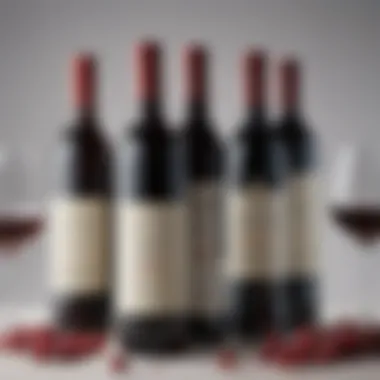Exploring the World of Low-Calorie Red Wines


Intro
Low-calorie red wines are becoming increasingly popular among health-conscious individuals who still want to enjoy the pleasures of wine. This growing interest pivots not only on the inherent flavors of these varietals but also on the reduced caloric content that allows for moderation without sacrifice. Each type of red wine, from Pinot Noir to Merlot, has its unique characteristics and caloric values, which can better inform consumers.
The relevance of this discussion lies in the need for more informed choices surrounding wine consumption. With the right information, wine lovers can indulge mindfully. This exploration will delve into various low-calorie red wines and their health implications. Understanding how factors such as sugar content and alcohol level affect calories is essential in making selective choices when it comes to enjoying a glass of red without feeling guilty about excess calories.
Let’s now outline key aspects of this guide, focusing on low-calorie values, selection tips, health considerations, and the enjoyment of these wines with various culinary experiences.
Preface to Wine and Caloric Content
Red wine has long been a staple in kitchens and dining tables across the world. Understanding the caloric content in wine is essential for those who appreciate it but want to maintain a mindful approach to what they consume. With a growing trend towards health consciousness, many individuals seek to enjoy the pleasures of wine without the burden of excessive calories. This section aims to illuminate how caloric content affects one's wine choices, ensuring a more informed decision when selecting a bottle.
Defining Calories in Wine
Calories are a measure of energy provided by food and beverages, and wine is no exception. Each bottle of red wine contains a varying number of calories, primarily influenced by its ingredients, sugar content, and alcohol level. Typically, a standard glass of red wine contains about 125 to 130 calories. However, these values can fluctuate significantly among different varietals. Understanding what constitutes the caloric content in wine is necessary not just for the health-conscious individual but also for those who wish to enjoy wine without guilt.
Why Caloric Content Matters
The relevance of caloric content in wine can not be overstated. Many people are keenly aware of their dietary intake and how various beverages fit into their overall caloric budget. Wine offers richness in flavor and culture, but with a myriad of options available, one must consider how the choice of wine impacts health goals.
- Weight Management: For those managing weight, the number of calories can significantly influence dietary choices. Opting for lower-calorie varieties allows for enjoyment without compromising progress on health goals.
- Mindful Consumption: Knowledge of caloric content promotes mindful drinking. This awareness encourages consumers to choose wines thoughtfully, aligning choices with personal lifestyle preferences.
- Social and Cultural Experiences: Wine often accompanies meals during social events. Being cognizant of calories enables individuals to enjoy these experiences without derailing health efforts.
"Wine is not only a drink but a journey that can be enjoyed wisely."
As the conversation around health and wellness continues to evolve, educating oneself about what is in the glass becomes more important. The following sections will delve into the factors influencing the caloric content in red wine, identifying low-calorie options, and their health implications.
Factors Influencing Caloric Content in Red Wine
The caloric content of red wine is not solely determined by the type of grape used. Several factors come into play that can affect the total calories in a glass of wine. Understanding these influences helps consumers make informed choices. This section discusses essential elements that dictate caloric levels in red wine, focusing on sugar content, alcohol levels, and serving sizes.
Sugar Levels in Wine
One of the primary determinants of caloric content in red wine is its sugar level. The presence of residual sugar, which can remain after fermentation, typically increases the calorie count. Wines with higher sugar levels tend to exhibit a sweeter taste, and consequently, they can have more calories.
- Dry Wines: Generally, dry red wines like Cabernet Sauvignon or Pinot Noir have lower sugar levels. These wines are fermented untils most of the sugar is converted into alcohol, resulting in fewer total calories.
- Sweet Wines: In contrast, sweet wines, such as certain Rieslings, can contain a significant amount of residual sugar, pushing their caloric content higher. When looking for low-calorie options, it's essential to consider the label for terms like "dry" or "off-dry" when selecting red wines.
Alcohol Content and Calories
The alcohol percentage in wine is another critical component for determining its overall caloric content. Ethanol itself is high in calories. Thus, as alcohol content increases, the calorie count often rises as well.
Typically:


- Lower Alcohol Wines: Wines with an alcohol level around 12% usually contain fewer calories. For instance, a bottle of Pinot Noir can be a smart option due to its moderate alcohol content and lower sugar levels.
- Higher Alcohol Wines: Wines that have alcohol percentages exceeding 14% may lead to a higher caloric intake because of the additional calories from alcohol.
It's essential to balance the enjoyment of wine with awareness of how its alcohol content contributes to its caloric density.
Serving Size Considerations
Serving size also plays a pivotal role in the caloric intake from red wine. The standard serving size for wine is 5 ounces. However, it's common in social settings to pour larger servings. This can lead to unintentional overconsumption of calories.
- Standard Serving: Sticking to a standard 5-ounce pour helps maintain a control over caloric intake.
- Larger Portions: Opting for larger servings can dramatically increase total caloric consumption from wine.
Understanding how different factors like sugar, alcohol content, and serving size influence the caloric content of red wine allows wine lovers to enjoy their drink more mindfully. This awareness ensures that the choice of low-calorie red wine aligns more closely with dietary goals and health considerations.
Identifying Low-Calorie Red Wines
Identifying low-calorie red wines is crucial for those who enjoy wine but wish to maintain a mindful approach regarding calorie intake. With the increasing awareness of health and wellness, consumers today are more discerning about the beverages they choose. Recognizing which red wines offer lower calorie options can greatly enhance the dining experience without compromising dietary goals.
Low-calorie red wines are typically characterized by lower sugar content and moderate alcohol levels. These two factors play significant roles in determining the caloric content. Choosing these wines does not mean sacrificing quality or taste; many varietals maintain rich flavor profiles while adhering to healthier caloric specifications.
When selecting low-calorie red wines, knowledge about specific varietals can guide consumers towards better choices. Each varietal comes with unique characteristics that appeal to different palates, yet some notably stand out in the low-calorie category. Understanding these varietals allows enthusiasts to appreciate wine without the guilt of excess calories.
Pinot Noir
Pinot Noir is renowned for its elegant complexity and low-calorie nature. This varietal typically contains fewer calories compared to fuller-bodied reds. On average, a 5-ounce serving of Pinot Noir contains approximately 121 calories. This makes it a favored option among health-conscious wine drinkers.
Its flavor profile ranges from light cherry to earthy undertones, offering a refreshing experience. Moreover, Pinot Noir's acidity pairs well with a variety of foods, making it versatile for different dining occasions. This wine is often described as bright and smooth, appealing to those who appreciate subtlety in their wines.
Merlot
Merlot is another popular choice for those seeking low-calorie red wines. Typically, a 5-ounce serving of Merlot has around 150 calories. It features a softer texture and often exhibits fruity flavors such as plum and black cherry. This makes Merlot approachable, even to those new to red wines.
The moderate caloric content coupled with its accessibility encourages wine lovers to indulge without significant guilt. Merlot also pairs nicely with diverse dishes, from grilled meats to hearty pasta, making it a staple in many households.
Cabernet Sauvignon
Cabernet Sauvignon is known for its bold profile, but surprisingly, it can also be low in calories. A 5-ounce serving typically contains approximately 123 calories. With notes of dark fruits and spices, this varietal offers a more robust option for discerning palates.
For those who enjoy a fuller-bodied wine, Cabernet Sauvignon provides satisfaction without excessive calorie intake. Its complex flavors and longevity in aging add depth, making it a prized selection for collectors and casual drinkers alike.
Shiraz/Syrah
Shiraz, or Syrah as it is known in some regions, presents another excellent option for low-calorie wine enthusiasts. Generally, a 5-ounce serving has about 135 calories. This varietal is often celebrated for its rich, peppery notes with a hint of fruit.


Shiraz can be bold yet easy to drink, appealing to both casual and experienced wine drinkers. Its ability to complement grilled meats and spiced dishes enhances its value in culinary contexts. Overall, Shiraz occupies a unique space in the low-calorie wine category, balancing flavor and caloric considerations effectively.
Comparative Analysis of Popular Low-Calorie Varietals
The ability to choose a wine that aligns with dietary preferences is vital for many consumers today. Low-calorie red wines have become increasingly popular due to a heightened awareness of health and wellness. This section will delve into a comparative analysis of notable low-calorie varietals, helping readers understand their caloric differences, flavor profiles, and suitable occasions for enjoyment. By doing so, readers can make more informed decisions that enhance their dining experiences.
Caloric Breakdown of Varietals
When exploring low-calorie red wines, understanding their caloric breakdown is essential. Calорий content can differ significantly among various types of wines. For instance:
- Pinot Noir tends to be on the lower end, often containing around 120-130 calories per five-ounce glass.
- Merlot typically contains about 140 calories per serving.
- In contrast, Cabernet Sauvignon can be heavier, averaging around 150 calories.
- Shiraz, depending on the producer, can also reach similar calorie counts as Cabernet Sauvignon.
These values illustrate the need for careful selection. Readers should look for varietals with lower sugar content and moderate alcohol levels, as these factors typically correlate with reduced caloric values.
Tasting Notes and Profile
Evaluating the tasting notes of low-calorie red wines is just as important as understanding their caloric content. Each varietal offers distinct characteristics that affect flavor and overall experience:
- Pinot Noir features light body with delightful notes of cherry, raspberry, and subtle earthiness. It's versatile for food pairings, working well with lighter dishes.
- Merlot presents a fuller body with flavors of plum, chocolate, and velvety tannins. Its smooth finish makes it a crowd-pleaser.
- Cabernet Sauvignon is robust and bold, with deep flavors of black currant, cedar, and spice. This wine pairs excellently with hearty meals.
- Shiraz offers a spicy profile with rich fruit flavors like blackberry and plum, appealing to those craving a bolder taste.
Understanding the tasting profiles enables enthusiasts to choose wines that not only align with their health goals but also complement their culinary experiences effectively.
"Choosing the right wine can elevate a meal and ensure enjoyment without dietary guilt."
For wine lovers, integrating this knowledge means making decisions that enhance social experiences while remaining health-conscious.
Health Implications of Drinking Low-Calorie Red Wine
Understanding the health implications of low-calorie red wine is essential for wine enthusiasts who wish to enjoy this beverage with greater mindfulness regarding their caloric intake. Choosing a low-calorie option allows drinkers to savor wine without the added guilt or consequences of excessive calorie consumption. This consideration is particularly relevant for individuals who are conscious of their dietary habits or those who incorporate wine into their lifestyle but do not want it to hinder their health goals.
Wine, in moderation, can offer certain health benefits, which can be maximized when selecting lower-calorie varieties. Being informed about how low-calorie red wine can fit into a balanced diet presents an opportunity to enjoy its flavors while being aware of one’s nutritional intake. Now, let's delve into moderation and its effects on health, along with the antioxidant properties that these wines may possess.
Moderation and its Effects
Moderation is a crucial concept when considering alcohol consumption. The idea of moderate drinking can vary from person to person, but general guidelines suggest limiting alcohol intake to one drink per day for women and two drinks per day for men.
The benefits of moderation in consuming low-calorie red wine include:
- Lower risk of health issues linked to excessive alcohol consumption, such as liver disease or certain cancers.
- Ability to enjoy wine without significant caloric impact, allowing for a more balanced diet.
- Enhanced tasting experience, as moderation encourages a greater appreciation for the wine’s flavor and aroma.
However, excess intake, even of low-calorie options, can lead to unhealthy habits and diminish the positive impacts associated with moderate wine consumption. It is therefore important for drinkers to be mindful of their portions and overall alcohol consumption.


Antioxidant Properties of Red Wine
Another aspect to consider is the antioxidant properties found in red wine, which can offer health benefits when consumed responsibly. Red wine contains compounds such as resveratrol and flavonoids that are known for their antioxidant effects. These antioxidants can contribute to:
- Reducing oxidative stress, which can damage cells and contribute to aging and disease.
- Supporting heart health by improving blood flow and potentially lowering the risk of heart disease.
- Enhancing overall wellness by promoting healthy inflammation responses in the body.
While low-calorie red wines still carry these antioxidant benefits, it is essential to note that the health impact significantly depends on the amount consumed. Wine drinkers should approach their choices with a balance between enjoyment and health awareness.
"Moderation in all things, including wine, provides the best chance for health benefits without the weight of excess calories."
Practical Tips for Choosing and Enjoying Wine
Choosing and enjoying low-calorie red wine not only enhances the experience but also aligns well with a mindful lifestyle. This section aims to provide clear guidance on how to make informed choices when selecting wines, ensuring that health considerations remain front and center.
Reading Wine Labels Effectively
Reading wine labels is an essential skill for anyone looking to understand the caloric content of red wines. Labels provide information such as the alcohol percentage, residual sugar, and other factors that contribute to calorie counts. A good starting point is to look at the alcohol by volume (ABV). Generally, the higher the ABV, the more calories the wine may contain.
Some wines include detailed nutritional information which can help further pinpoint caloric value. For example, a wine with 12% ABV often has fewer calories than one with 15%. Additionally, understanding terms like "dry" and “sweet” can aid in distinguishing between the sugar levels present in the wine. Remember that a dry wine typically has lower sugar, thus fewer calories.
Selecting Wine for Occasions
Selecting the right wine for various occasions often depends on the context of consumption (e.g., casual gatherings, formal dinners, or special events). For casual settings, consider opting for lighter options such as Pinot Noir which usually has lower calorie content and pairs well with a variety of foods. Conversely, if hosting a formal dinner, a bottle of Cabernet Sauvignon may impress guests while still being mindful of their caloric intake.
It is also beneficial to factor in the culinary elements of the occasion. Understanding the principal dishes being served can guide wine selections, ensuring harmonious pairing and enjoyment without consuming excessive calories.
Pairing Food with Low-Calorie Red Wines
Pairing food with low-calorie red wines is an art that elevates the dining experience. When choosing food pairings, the focus should be on balance in flavors. Many low-calorie red wines complement dishes that are balanced in fat and protein. For instance:
- Grilled chicken pairs well with a light Pinot Noir.
- Roasted vegetables can be complemented by Merlot.
- Salmon matches nicely with a delicate Shiraz/Syrah.
A successful pairing not only enhances the meal but also allows for a more enjoyable wine experience without overindulgence. Prioritize fresh herbs, spices, and less heavy sauces to maintain low-calorie principles in both food and wine.
Remember, the focus is on enjoyment and moderation, rather than on guilt or excessive calorie counting.
In summary, approaching the selection and enjoyment of low-calorie red wine with these practical tips can enhance the pleasure of sipping wine while prioritizing health.
The End
The exploration of low-calorie red wines reveals crucial insights for those wishing to enjoy wine without compromising health or dietary goals. Low-calorie choices provide an opportunity to indulge while remaining mindful of caloric intake. This article has highlighted the importance of understanding both the factors affecting caloric content in wines and the specific varietals that are lower in calories.
Choosing wines like Pinot Noir and Merlot not only supports a balanced lifestyle but also opens up a world of flavors and experiences. These wines, often offering rich profiles with less sugar and alcohol, can complement various dishes without adding unnecessary calories.
When selecting wine, it becomes necessary to read labels thoroughly. Knowledge of serving sizes, sugar levels, and alcohol content serve as the foundation for making informed decisions. These considerations are not only beneficial for individuals mindful of their caloric intake but also essential for those exploring healthy drinking habits.
In summary, the benefits of low-calorie red wines extend beyond just caloric considerations. They support a holistic approach to enjoying wine. Whether for a special occasion or a casual evening, low-calorie options provide balance without sacrificing flavor.
The final thought rests on the notion that enjoying wine can and should coexist with personal health goals. As we become more aware of our choices, the world of wine becomes both inviting and nourishing.







